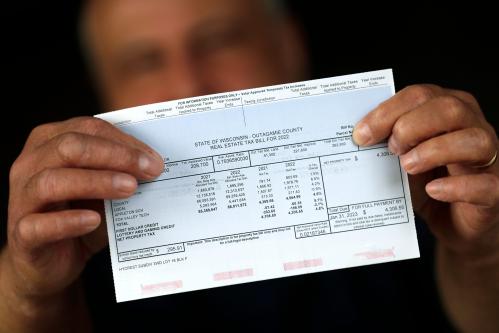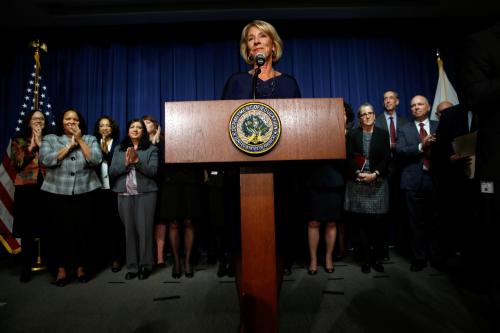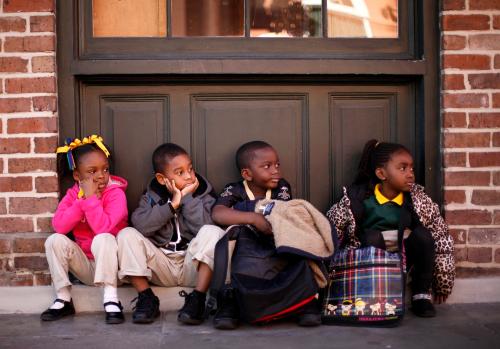With Betsy DeVos at the helm of the Department of Education, speculation abounds about whether and how the federal government will enact a private school choice program that authorizes spending public funds on private schools.
The nonpartisan National Conference of State Legislatures (NCSL) identifies three types of private school choice programs: vouchers, education savings accounts (ESAs), and scholarship tax credits. The Trump administration is currently pursuing federal versions of two of these types of programs. His proposed budget includes federal spending on a school voucher program, and many anticipate that the administration will try to include a federal scholarship tax credit program in their tax reform efforts. But the fate of Trump’s budget and of Republicans’ efforts to overhaul the tax code remains highly uncertain.
In the absence of a federal private school choice program, does this mean we will see little movement toward this type of school choice reform? Not necessarily. Many states have adopted at least one of these types of programs, and with 33 Republican governors—24 of whom enjoy unified party control of the governorship and state legislature—these policies may spread quickly across states in the near term.
Variation in private school choice programs
While different, vouchers, ESAs, and scholarship tax credits share an important (and controversial) trait: providing parents the option of using public funds for students to attend private schools.
Vouchers are state-funded school choice programs that “allow students to use public monies to attend a private school.” ESAs have a similar aim, but are different in design. Typically, to use these funds, parents whose students formerly attended public school must agree to send their children to private schools and can spend the ESA funds on education services like tutoring, textbooks, or private school tuition, depending on the state. Under scholarship tax credit programs, individuals and corporations may allocate some of their owed taxes to a scholarship program that provides scholarships (vouchers) to students. As in the case of traditional voucher programs and ESAs, these scholarships may fund private school tuition and other educational expenses.[1]
Current patterns in state-level implementation
The nonpartisan Education Commission of the States reports that 14 states and D.C. currently operate voucher programs, with some states operating more than one. This tally includes Vermont and Maine, where “town tuitioning” programs were adopted prior to the 20th century to allow students who reside in districts without public schools to use public funds to attend public or private schools in other districts. Given the difference between town tuitioning programs and typical voucher programs, we omit them on the map below. Beyond vouchers, five states have enacted ESA programs as of June 2016, and the NCSL reports that 17 states currently operate scholarship tax credit programs. The map below illustrates which states operate these various programs.

Wisconsin enacted the first voucher program in 1990, while Maryland enacted the newest program in 2016. Arizona enacted the first ESA program in 2011, with other states following suit through 2016. Arizona also enacted the first scholarship tax credit in 1997, and South Dakota implemented this program in 2016.
There is a loose regional pattern to these adoptions, with states in the South and Southwest leading the way. In general, the Northeast, Pacific coast, and parts of the Midwest have yet to embrace these programs.
Currently, almost all voucher programs are designed to serve students with disabilities, students from low-income backgrounds, or students attending underperforming schools. While the majority of ESA programs are designed to serve students with disabilities (four of the five), the majority of scholarship tax credit programs target low-income families (13 out of 21 programs). Some states have universal programs: Nevada’s ESA program is open to all students, and Montana has a universal scholarship tax credit program.
There is substantial variation across states in terms of accountability. Almost half of the voucher programs do not have any testing requirement or only have to provide parents with a progress report about their children. In other voucher programs, schools must administer a state or a nationally standardized assessment to their voucher recipients; in some programs, participant schools would be included in the state school grading system. Among the five states with ESA programs, three states—Florida, Nevada, and Tennessee—require participants to take a standardized test. In terms of scholarship tax credits, we observe fewer accountability requirements. Only eight of the 21 programs require students to take a state or national test.
State-level enthusiasm masked in national polls?
There is a distinct partisan pattern to the adoption of ESA and voucher programs. Of the 49 total voucher, ESA, and scholarship tax credit programs currently in operation across 25 states, 44 programs were signed into law by Republican governors. The five programs enacted by Democratic governors include Oklahoma’s voucher program, enacted in 2010, and the scholarship tax credit programs in Arizona (2006), Iowa (2006), Montana (2015), and New Hampshire (2012).
To many, it will not be surprising that Republican governors have implemented almost all of these policies. The GOP is typically supportive of these programs, while Democrats and teachers’ unions are often critical. Consider, for example, that the vast majority of states that currently operate at least one of these three private school choice programs voted for Trump in the 2016 election, with the exceptions of Maryland, Virginia, Nevada, New Hampshire, and Rhode Island.
What this map also suggests is that Republican governors’ enthusiasm for these programs may translate into more state-level traction than we might otherwise infer from recent polling data. On the 2015 Phi Delta Kappa poll, 57 percent of respondents were opposed to “allowing students and parents to choose a private school to attend at public expense,” while only 31 percent supported this approach. Democrats, predictably, were overwhelmingly opposed (71 percent), but Republicans themselves were evenly split on the matter: 46 percent were in support, and 46 percent were opposed. But the adoption patterns just discussed suggest that this tepid support in national polling could mask support for specific programs among the public in Republican-leaning states, or at least among Republican state legislators and governors.[2]
Widespread potential for state-level adoption of vouchers, ESAs, scholarship tax credit in near-term
With the fate of Trump’s budget unknown, it remains unclear whether the Department of Education will receive a green light anytime soon to direct funds toward a federal voucher or scholarship program. At the same time, Republican governors whose states have not yet enacted private school choice programs may follow the example set by their peers. Of the 33 Republican governors currently in office, 24 preside over states with unified government, and seven of these states have adopted none of the three programs, while 11 have adopted only one, leaving quite a lot of room for these various programs to spread across states under Republican control.
These states may be prime candidates for adoption of private school choice programs in the near-term. Indeed, political scientists have found that states are more likely to adopt policy innovations if neighboring states have adopted similar programs. In the context of school choice, Michael Mintrom finds that states whose neighbors had considered school choice legislation were themselves more likely to consider school choice bills (though were not more or less likely to approve these bills). Applying this logic of “regional diffusion” to vouchers, ESAs, and tax credits, we might expect likely adopters to include states with Republican governors whose neighbors have enacted one or more of these programs. Further, the seven states with unified Republican government who have not yet adopted one of these programs may be particularly likely adopters (black dots on the map below identify the 24 states with unified Republican government). For example, states such as Idaho, Texas, Missouri, Kentucky, and Michigan may be prime candidates for adopting one or more of these programs.

Variation across new programs likely
Even if Republican governors aggressively push to adopt one or more of these private school choice programs in the near future, these programs will likely continue to vary across states. As in the case of charter schools, state-level variation means that accountability requirements will likely vary. Further, as with charters, some programs may have positive effects on student learning, while others do not.
Regardless of whether Trump and DeVos can convince Congress to authorize federal programs that send public funds to private schools, voucher, and ESA programs, tax credits will likely spread at the state level. In turn, debates will certainly persist over whether these types of funding mechanisms adequately serve their target populations, and in particular, low-income students and students with disabilities.
Footnotes
[1] We relied on data from ECS, NCSL, and EdChoice to compile these summaries.
[2] It is worth noting that, unexpectedly, the 2016 EdNext poll found that more Democrats than Republicans favor both targeted vouchers available for specific populations and universal voucher programs. About 58 percent of Democrats reported support for targeted vouchers, and 56 percent supported universal vouchers, while 51 and 45 percent of Republicans supported these programs, respectively. The overall level of support for scholarship tax credit programs is slightly higher overall, and again, slightly more Democrats supported this policy (69 percent) compared to Republicans (60 percent). Rather than reflecting hidden Democratic support for these programs, these counterintuitive findings may instead reflect a low level of public understanding about what these specific programs are, with respondents failing to link vouchers and scholarship tax credits to spending public funds on private schools. Consequently, the 2015 Phi Delta Kappa question framing likely offers clearer insight into support for private school choice programs.








Commentary
States could lead the way in private school choice program expansions
April 5, 2017